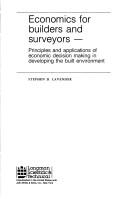This book is intended for students, lecturers and practitioners in a wide range of build environment disciplines including building, quantity surveying, estate management, and town planning. In particular, the book is designed for use on degree, professional and technician courses in these disciplines. In addition to being suitable for teachers of economics, the book should assist lecturers in subjects such as building management, cost planning, property market studies and land use planning, to integrate aspects of economic analysis into their teaching. It should also be of interest to practising builders and surveyors who wish to gain a wider understanding of the economic forces which influence their work. The book, which is in three parts, seeks to emphasize the importance of economic decision making in developing the built environment. No prior knowledge of economics is assumed. Part one shows, with the aid of a case study and an illustrative framework of the development process, how economic problems can be understood and solved partly by a "common sense" approach.
Part two deals with the principles of economcs, emphasizing economic decision making rather than economics as an academic discipline. Economic theory is reduced to its essentials whilst ideas from related disciplines such as management are assimilated. The result is a set of principles which are used in a variety of applications in part three to help explain economic decision making in developing the built environment.
- ISBN10 058204295X
- ISBN13 9780582042957
- Publish Date 30 July 1990
- Publish Status Out of Print
- Out of Print 1 November 2009
- Publish Country GB
- Publisher Pearson Education Limited
- Imprint Longman
- Format Paperback (UK Trade)
- Pages 334
- Language English
